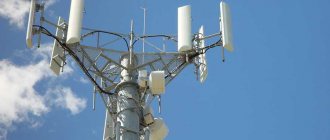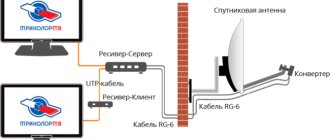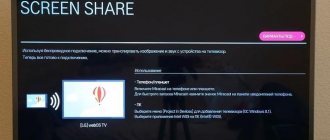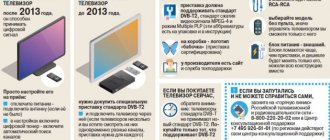How to connect to digital television? Video report by Sergei Stanchik
Digital broadcasting throughout Primorye. Starting this year, residents of even the most remote areas of the region will be able to watch 20 TV channels, which are available after the installation of the second multiplex. Everyone can connect to digital television. You just need to put in a little effort. What needs to be done?
In 2021, Primorsky Krai, like the whole country, will finally switch from analogue to digital broadcasting. This is a big step for domestic television. Digital provides much higher quality picture and sound. Now a second multiplex has been launched in Russia, which allows you to watch 20 TV channels in modern quality. Primorye residents who have new generation TVs will be able to receive a digital signal without additional equipment. Everyone else will need a special attachment.
Evgeny Ponomarev, head of the support center of the RTRS branch “Primorsky KRTPC”: “Modern digital television - it transmits an audiovisual signal in encoded form, using mathematical algorithms. Televisions that receive an analog signal, such as telescopic ones, are not capable of extracting video and sound from these ones and zeros and displaying them on the screen. Separate devices are required that will perform these functions.”
Connecting to digital broadcasting is quite simple. In the menu of the set-top box or the TV itself, we launch an automatic search. If all 20 channels are found, the setup is complete. If not, check where the antenna is pointing. If there is a “digital” TV tower in your locality, point the antenna in its direction and run the auto channel search again.
Evgeny Ponomarev, head of the support center of the RTRS branch “Primorsky KRTPC”: “On the screen we see a scale of signal level and quality. We move the antenna left, right. Focusing on how the signal indicators change.”
If all the steps have been completed, but you cannot receive 20 TV channels in good quality, you need to check the condition of the antenna. It is recommended to replace homemade equipment with factory equipment. And if the distance to the TV tower is long—more than 15 kilometers—experts recommend installing a signal amplifier. But there is one more point! There are still settlements in Primorye where the digital signal does not reach.
Alexey Grabkov, director of the Primorsky branch of RTRS: “The percentage throughout the Primorsky Territory corresponds to 98.6%. This is approximately 1.9 million inhabitants..."
Digital broadcasting has not yet arrived in some localities due to remoteness or difficult terrain. But, nevertheless, according to the head of the region, by the time analogue broadcasting in Primorye is cancelled, all houses in the region will be able to receive a digital television signal.
Oleg Kozhemyako, governor of the Primorsky Territory: “Yes, there are about 20 thousand households where mechanisms for directly installing satellite dishes will be used.”
For the installation of satellite equipment, pensioners, large and low-income families will be able to receive compensation of up to 6 thousand rubles. For all questions regarding digital TV signal reception, residents are advised to contact RTRS.
Source: “Vesti:Primorye” [ www.vestiprim.ru ]
Evgeny Ponomarev: “20 digital TV channels will soon be available to all Primorye residents”
From January 1, 2021, all regions of Russia, including the Primorsky Territory, are required to switch to digital television broadcasting. The head of the external communications department of the Primorsky regional branch of the Russian Television and Radio Broadcasting Network, Evgeniy Ponomarev, said in an interview with PRIMPRESS that the Primorsky outback will be able to master “digital” before the end of this year, and gave practical advice on how to prepare for this.
– Why did it decide to reduce analogue broadcasting in Russia?
– Analogue broadcasting does not meet the needs and interests of the modern TV viewer. People are accustomed to the fact that the Internet is unlimited, television is high definition and has many channels. When a consumer is offered 2-3 channels of not very good quality, naturally this cannot satisfy him.
The government has developed a federal target program, according to which analogue broadcasting should be replaced by digital. From January 1, 20 channels of excellent quality will be shown throughout the country, without any interference.
– Why is analogue broadcasting worse than digital?
– Analogue television was very dependent on reception conditions. In order for a person to get a normal picture on his TV, it had to be located as close as possible to the transmitting station and have a good antenna. There should be no interference along the signal path from the TV tower: in the form of terrain, buildings, trees, electromagnetic fields. All these factors negatively affected the picture that the viewer saw on TV.
With digital television everything is simpler. The image is either “one” and it is perfect, or “zero” and it is not there at all. Accordingly, to obtain a clear picture of digital television you need to put in much less effort than in the case of analogue broadcasting. There are no problems such as double-triple images - when signals from different TV towers or from different directions arrive at one antenna. There is no moiré, noise or interference. The “numbers” picture is a mathematically verified ideal image. This image is not affected by any external interference.
In addition, the sound is presented in stereo rather than mono, as in analogue television. The result is a more voluminous sound image.
– Is Primorsky Krai ready to switch to digital?
– The region is completely ready. There is very little time left before the final transition. In the fall, we plan to begin broadcasting the second multiplex (a dozen programs) in those settlements where such broadcasting does not yet exist. This is a significant part of the outback region. Currently, all 20 channels are broadcast only in large cities with more than 50 thousand residents.
In other settlements, 147 transmitters broadcast only the top ten socio-political channels. By the end of the year, 20 channels will cover the entire region, more precisely, 99.72% of the population.
As a result, almost all Primorye residents will be able to watch 20 state digital channels absolutely free, without subscription fees.
– How should residents of the outback prepare for the change in television broadcasting from analogue to digital?
– Today, residents of villages and villages receive terrestrial or satellite television. Those who watch analog television see the letter “A” next to the channel logo. Towards the end of the year this broadcast will stop. In order not to find yourself without television, you will need to switch to digital broadcasting. You need to decide whether the TV supports digital signal reception. If it supports, it will be enough to simply start an automatic search for channels. They will be found - you can watch digital television.
If the TV does not support digital television, there are two options. The first is buying a new TV, the second, more budgetary, is purchasing a digital set-top box that you need to connect to your TV. All the work of decoding and processing the digital signal will be performed not by the TV, but by the set-top box.
– Is it possible to determine to what extent the television equipment of a particular household is ready to accept “digital”?
– TVs that were released in the second half of 2012 all support the digital standard. Those released earlier do not support the DVB-T2 broadcast standard, on which we broadcast.
In fact, you need to remember the abbreviation DVB-T2 and, when you go to any household appliances store, ask the seller to show you the set-top boxes for digital television. Each one usually has a logo pasted on it, which indicates which standard this set-top box supports. All set-top boxes sold in Russia support the DVB-T2 standard and Multy PLP mode. This mode is needed to ensure that all channels are displayed correctly - thanks to it, we are regionalizing the channels “Russia-1” and “Russia-24”. Problems may arise with consoles imported from China.
– Is it difficult to connect the TV to the set-top box?
– Anyone can connect a set-top box to a TV, regardless of gender, age or technical knowledge. The connection follows the same principle as a DVD player or VCR. The set-top box has outputs designated by colors: white, yellow, red, and similar inputs are on the TV. Connection occurs by color. The antenna cable that was on the TV must be connected to the set-top box. In addition, some people forget to plug the set-top box into the power supply. After connecting, you will be prompted to configure the channels. Click “OK”, the set-top box detects digital channels, and you watch them. In practice, set-top boxes are freely set up by pensioners and junior schoolchildren. Please note that each TV requires a separate set-top box.
– But this is an increase in budget expenditures?
– Acting Governor of the Primorsky Territory Andrei Tarasenko decided to develop a bill providing for compensation for the purchase and installation of equipment for the most needy categories of the population.
A measure of one-time support - six thousand rubles - will be available to pensioners, large and low-income families, as well as low-income citizens living alone.
At the same time, the residential premises of applicants for a subsidy must meet several requirements: be located in an area outside the coverage area of digital terrestrial television, owned as property, or used on the basis of a social tenancy agreement. Permanent residence in the house must be confirmed by registration at the place of residence.
The draft law “On state support for citizens of the Russian Federation living in the territory of the Primorsky Territory in settlements outside the coverage area of digital terrestrial television” will soon be considered by deputies of the Legislative Assembly of the region.
– Where and how can I get advice if I still have questions?
– If you have any questions, you can always contact the RTRS information center by phone 8-800-220-20-02 (toll-free from anywhere in Russia) or the Primorsky Advisory Support Center by phone during business hours. It is possible to write a letter by e-mail or contact Vladivostok directly at the address: st. Lazo, 2.
– How true are the rumors about the transfer to a digital format of radio broadcasting?
– Currently, work is underway in the direction of digital radio broadcasting. There are some developments in this direction, but it is too early to talk about the timing. There are no plans to transition before 2021.
– What is the fate of analogue television broadcasting?
– In the 4th quarter, gradual broadcasting of the second multiplex will be introduced, which includes entertainment channels. The launch will take place at 147 transmitting stations throughout the region, from Posyet to Terney. Primorsky Krai is large; our groups that will bring these objects out of standby mode will need some time. In December, residents of the region should be able to watch 20 free channels. In parallel, there will be a reduction in analogue broadcasting. There are 600 settlements in our region, each with at least 1-2 analogue transmitters broadcasting. The fate of analog channels that operate in cities with more than 100 thousand people will be decided by their owners. If they want to save it, they will save it. According to our data, in large cities analogue broadcasting will remain in full or in part.
Digital TV in Primorye
With the transition to digital terrestrial television , residents of many remote areas began to watch ten free federal channels in excellent quality. The transition to a new era of television broadcasting is in full swing.
Channel list:
| № | Name |
| 1 | "First channel" |
| 2 | "Russia 1" |
| 3 | "Russia 2" |
| 4 | "NTV" |
| 5 | "Channel Five" |
| 6 | "Russia K" |
| 7 | "Russia 24" |
| 8 | "Carousel" |
| 9 | Public television of Russia |
| 10 | TV Center |
| 1 | radio "Radio Russia" |
| 2 | radio "Mayak" |
| 3 | radio "Vesti FM" |
Settlements and areas where DTV broadcasts take place
Dalnegorsky urban district : Dalnegorsk, Rudnaya Pristan 33 TVK.
Dalnegorsky district: Kamenka 33 TVK.
Dalnerechensky district : Dalnerechensk, Orekhovo, Polyany, Ariadnoye, Zimniki, Lyubitovka 23 TVK.
Kavalerovsky district : Bogopol, Sinegorye, Ustinovka, Vysokogorsk 33TVK.
Kirovsky district : Gorny, Krylovka 49 TVK.
Krasnoarmeysky district : Glubinnoye, Romny, Vostretsovo, Izmailikha, Melnichnoe 23 TVK and Vostok 51 TVK.
Lazovsky district : Benevskoye, Glazkovka, Staraya Kamenka, Valentin, Danilchenkovo, Chisinau, Sokolchi, Chistovodnoye 35 TVK.
Lesozavodsk district : Glazovka 49 TVK, Lesozavodsk 49 TVK, Tamga 23 TVK.
Mikhailovsky district : Novozhatkovo 36 TVK and Lyalichi, Tarasovka 49 TVK.
Nadezhdensky district : De-Fries, Razdolnoye, Steklozavodskoy 37 TVK.
Nakhodka urban district : Nakhodka 35 TVK.
Oktyabrsky district : Chernyatino, Poltavka, Novogeorgievka, Fadeevka 36 TVK.
Olginsky district : Listvennoe 35 TVK, Milogradovo 35 TVK, Margaritovo 35 TVK, Novonikolaevka 33 TVK, Olga 33 TVK.
Partizansky district : Molchanovka, Romanovsky Klyuch, Sergeevka, Slinkino, Ekaterinivka, Khmylovka 35 TVK.
Partizansky urban district : Partizansk, Khmelnitsky 35 TVK.
Border area : Barabash-Levada, Rubinovka, Boguslavka, Sergeevka 36 TVK.
Pozharsky district : Krasny Yar, Svetlogorye, Sobolinoye 51 TVK.
Spassky district : Chkalovskoe 49 TVK.
Terney district : Terney 29 TVK.
Ussuriysk urban district : Korfovka 36 TVK, Nikolo-Lvovskoye 36 TVK, Putsilovka 37 TVK, Ussuriysk 37 TVK, Yakonovka 37 TVK, Glukhovka 37 TVK, Alexey-Nikolskoye 37 TVK, Kondratenovka 37 TVK, Korsakovka 37 TVK, Krounovka 37 TV K, Monakino 37 TVK, Ulitovka 37 TVK.
Khankaisky district : Komissarovo 49 TVK, Novoselishche 36 TVK, Dvoryanka 36 TVK.
Khasansky district : Zanadvorovka 37 TVK, Kamyshevoye 36 TVK, Posyet 36 TVK, Filippovka 37 TVK.
Chernihiv district : Vassianivka, Merkushevka 49 TVK.
Chuguevsky district : Antonovka 33 TVK, Shumny, Lenino 33 TVK and Varpakhovka, Zametnoe, Izibriny, Kamenka, Koksharovka, Lesogorye, Pavlovka 49 TVK.
Shkotovsky district : Mnogoudnoye 37 TVK, Novonezhino 35 TVK, Smolyaninovo 37 TVK, Steklyanukha 37 TVK, Shkotovo 37 TVK, Shtykovo 37 TVK, Central 35 TVK.
Yakovlevsky: Ozernoe 49 TVK.
Also, those settlements that are located near the above will also be able to receive a digital terrestrial signal without any problems.
FL FSUE "RTRS" "PRIMORSKY KRTPC": address, phone, fax, email, website, work schedule
"RUSSIAN TELEVISION AND RADIO BROADCASTING NETWORK" "PRIMORSKY REGIONAL RADIOTV TRANSMITTING CENTER", BRANCH OF THE FEDERAL STATE UNITARY ENTERPRISE
Region: Primorsky Krai Vladivostok
Address: 690041, VLADIVOSTOK, st. RADIO, 9
Telephone:, (4232) 30-30-52
Fax: no data
Email: no data
Website: no data
General director / responsible person / owner of the FL FSUE "RTRS" "PRIMORSKY KRTPC": no data
Working hours: Mon-Fri: 8-19, Sat-Sun: 10-16
Found an inaccuracy in the description or want to provide more information about the company? - Write to us!
Detailed information about the FL FSUE "RTRS" "PRIMORSKY KRTPC": accounting, balance sheet. Download bank details, tenders, credit history, taxes of the FL FSUE "RTRS" "PRIMORSKY KRTPC".
FL FSUE "RTRS" "PRIMORSKY KRTPC" details: tax identification number, checkpoint, okopf, okogu, okpo, ogrn, okato
OGRN: 1027739456084
Taxpayer Identification Number: 7717127211
Checkpoint: 771701001
OKPO: 1163454
OKATO:
Receive an extract from the Unified State Register of Legal Entities about the legal entity of FSUE "RTRS" "PRIMORSKY KRTPC"
The FL organization FSUE "RTRS" "PRIMORSKY KRTPC" was registered on March 17, 1993. Registrar – Interdistrict Inspectorate of the Ministry of the Russian Federation for Taxes and Duties No. 39 for Moscow.
Representative offices and branches
Federal property
Types of activities according to OKVED: Communication Activities in the field of telecommunications Activities in the field of transmission (broadcast) and distribution of television programs Industry (according to OKONKH code): Electrical and radio communications
Types of activities under OKPD: Communication Activities in the field of telecommunications Activities in the field of transmission (broadcast) and distribution of television programs Industry (according to OKONKH code): Electrical and radio communications









